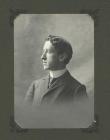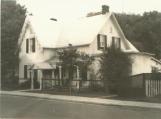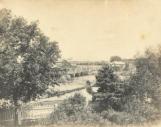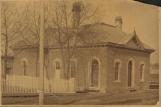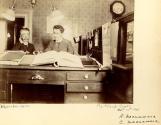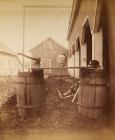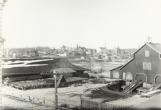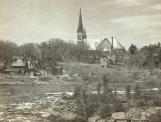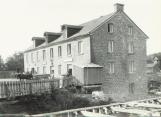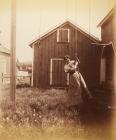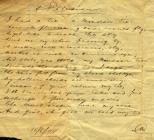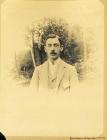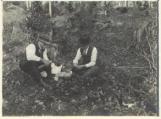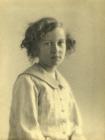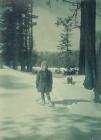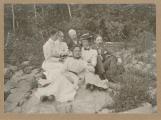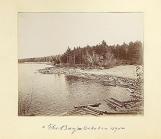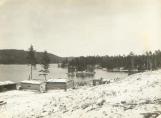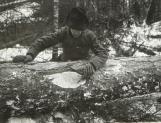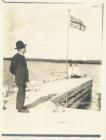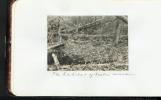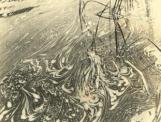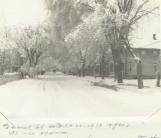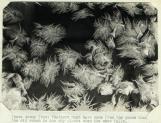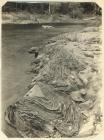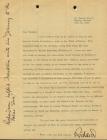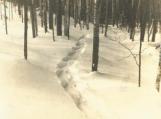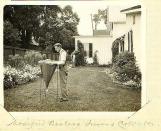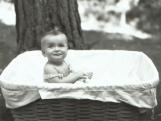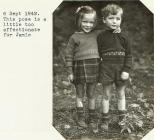

Arnprior McNab/Braeside Archives
Arnprior, Ontario
2
By the time William James Topley posed his subject for this formal portrait circa 1900, Charles Macnamara was already recognized locally for his skills as a talented amateur photographer and naturalist. Macnamara and Topley were both members of The Photographic Art Club of Ottawa which started exhibiting works to the public at 121 Sparks Street, Ottawa, in 1908. Unlike Topley, Macnamara never became a commercial photographer, or develop skills as a portrait photographer.Charles Macnamara was an educated man who preferred the silence of the bush to poetry readings or music recitals. He read Shelley, Thoreau, and Victor Hugo but did not care for Voltaire. He subscribed to the New York Times Literary Supplement which he tucked into his canvas bag to read while enjoying his cheese and onion sandwiches on his Sunday walks. He liked to sing popular songs and recite poetry, including his favourite poem the Lotus Eaters by Tennyson, during his solitary journeys into the bush just east of Arnprior. He wrote in his diary that, "It gives me a lot of pleasure to repeat poetry like this, but I simply hate to hear other people doing it."
Jean Macnamara Cunningham lived with her "Uncle Charlie" for many years. She wrote that "his membership in the 'Photographic Art Club of Ottawa' stimulated his interest in science and pictorial photos which he enlarged and sent to exhibitions in Ottawa, Montreal, and London England. He experimented with the newest printmaking techniques, often contrasting different processes as to clarity and artistic value. The Great War of 1914-1918 put a sudden stop to this exchange of pictures and his general interest in photography became a part of his growing study of natural history."
Macnamara described himself as an entomologist and a naturalist who preferred the "cold serene of science where I mostly like to dwell". He took a scientific approach in his studies of nature but possessed an artistic imagination and poetic sensibility when expressing these observations.
Leo Lavoie, author of The Arnprior Story gives credit to Charles Macnamara for providing him with historical information for his book. Macnamara was an amateur historian who was interested in the visit to Arnprior of the Prince of Wales in 1860. Macnamara also researched the various accounts of Samuel de Champlain's exploration to the new world. He wrote an article about an American Daguerrotypist, Solomon N. Carvalho who recorded Col. John C. Fremont's expedition into the Rio Grande in 1853.
Macnamara was a prolific writer and photographer who spent 14 years researching and documenting a beaver colony near Marshall's Bay, Ontario. He was responsible for setting up the Nopiming Game Preserve in 1920 to provide a safe habitat for local and migratory wildlife. The Macnamara Field Naturalist's Club was named after this extraordinary man.
For more details about Macnamara's life, work and legacy please follow the MARSHALL'S BAY, PHOTOGRAPHY, FIELD-NATURALIST and ENTOMOLOGY storylines.
4
Charles Macnamara was born in Quebec City in 1870, a twin to his brother Dickie who died at the age of 10 of typhoid fever. In 1880, Richard Macnamara and Richard Hannah (Richianna) Parnell Macnamara moved with Charles, his two brothers Duncan and Lewis as well as their sister Marian to Arnprior, Ontario. In 1901, Charles returned to Quebec City where he photographed the market, King's Wharf and the home where he was born.6
The Macnamara family moved into a house built by Daniel McLachlin for his son H. F. McLachlin in 1863. The house at 153 Daniel Street, was part of Richard Macnamara's salary when he moved to Arnprior in 1881. After it was purchased from the McLachlin's around 1913, a back kitchen and bay windows were added. This Victorian board-and-batten house was featured in City & Country Home magazine in 1987, when Jean Macnamara Cunningham (Charles Macnamara's niece) lived there.8
From Charles Macnamara's bedroom window he could look over the treetops and see part of the bridge over the Madawaska river, McLachlin Bros. Mill No. 1, office buildings and the lumber yard that stretched to the horizon.10
The McLachlin Bros. office was built at the eastern end of the Madawaska Bridge across from Mill No. 1 in the 1880's. From its windows, the managers could keep an eye on the lumber slide that fed timber coming from McLachlin's limits up the Madawaska to the mills at the mouth of the Ottawa river. Behind the office were several buildings that supported the lumber mills such as storage sheds, stable, blacksmith shop, wheelwright, harness shop, mess hall and yard office. Canadian Pacific Railway and Ottawa, Arnprior & Parry Sound railway sidings ran through this area from the main lines just south of McLachlin's yard.12
Richard Macnamara was secretary and later secretary-treasurer of McLachlin Bros. Lumbering Co. from 1881 to 1921. He retired two weeks before his death at the age of 86 years after 40 years of service to the McLachlin firm. Richard Macnamara was described as a very lively man who loved his work and liked to sing and dance. Charles Macnamara started working for the McLachlin's on December 21, 1885. He retired 48 years later in 1933. Charles was 24 when he composed this photograph using Flash Light to illuminate the office interior.14
Charles Macnamara started photographing his family and scenes of Arnprior in 1894. He experimented with double exposures early in his photographic career as this humorous photograph of his father demonstrates.Please follow the PHOTOGRAPHY storyline for more information about Charles Macnamara's photography.
16
Taken from the rooftop of McLachlin Bros. office, Macnamara captured a panoramic view of Mill No. 1 and the Town of Arnprior on a clear December day in 1894. Mill No. 1 was a water powered mill built by the McLachlin firm in 1866. Mill operations began in this area around 1833 when George and Andrew Buchanan established a grist mill and saw mill that was later abandoned. Daniel McLachlin bought the property in 1852 and rebuilt the mill and the dam in 1853. He had the town surveyed in 1854 and steadily expanded his operation. The population of Arnprior grew from approximately 100 prior to 1854 to just over 4100 in 1924.In 1869, Daniel McLachlin retired, leaving the business to his sons John H. McLachlin, Claude McLachlin and Hugh Frederick McLachlin. The firm continued under Claude and Hugh's direction when Daniel and John H. died in 1872. Claude McLachlin died in 1904 and in 1912 Hugh F. McLachlin died. From 1912 onward, Daniel McLachlin's grandson Dan was running the business by himself.
Mill No. 2 was a small mill called, "the little water mill" which was restricted to cutting cedar once the steam powered mills were built along the shore of the Ottawa river, east of the Madawaska river. In 1871, Mill No. 3 was built but it burnt four years later. It was rebuilt in 1882 and Mill No. 4 was erected in 1892. With the expansion from two mills to four, McLachlin's capacity increased from 2000 board feet/day in 1853 to 500,000 board feet/day in 1924. The firm expanded from a small workforce of 5 or 6 men to over 500 employees in the same time period. The bulk of wood sawn by the McLachlin mills was white pine, while spruce, red pine, hemlock and some larch were sawn at different times.
At the extreme right of the photograph you can see the steeple of the Roman Catholic church. From left to right the other churches shown in this photograph are Methodist, Anglican and Presbyterian.
18
St. John Chysostom Roman Catholic Church was built between 1904 and 1908. Father J. Alphonsus M. Chaine had the firm of Gauthier & Daoust of Montreal draw up the plans for this Gothic style, stone church. The church measured 162 feet long, sanctuary and vestry included, 70 feet wide in the main body of the church and 108 feet transept, 35 feet high. This is one of many photographs that Charles Macnamara took of this impressive structure. St. John Crystostom Separate School can be seen to the left of the church.Charles Macmara was a member of the Methodist church but did not frequently attend. He preferred to spend his Sundays orchid hunting or searching for signs of wildlife which he recorded in his diaries and photographs. He would, no doubt, have located and photographed the wild orchids which grow on the slopes of the Madawaska behind the church.
20
Taken from the rooftop of the office building, this view shows square timber ready to be cut, graded and piled before being shipped by railway to destinations all over the world. The Dontigny woolen mill and McLachlin's grist mill, located on the west bank of the Madawaska bridge, are visible at the extreme right of the photograph. The Town Hall can be seen in the centre of the photograph at the end of Madawaska street. The Arcade building and Galvin's Clothing Store are the two tall commercial buildings located to the left of the town hall in this photograph. The Macnamara home is the white home located in the centre, surrounded by a white picket fence and sheds with white trim. Charles was constantly surrounded by McLachlin Bros. buildings, employees and his close knit family.22
This closeup view of McLachlin's stone grist mill was taken in 1903. The grist mill was built between1851 and 1855 by Daniel McLachlin. In 1889, David Craig used the mill to manufacture flour. An article in the Chronicle's Holiday No. of 1904 outlined the changes to the interior of the mill. It reported that the capacity was now 175 barrels per day. It was equipped with "a grain separator, a grade and cockle machine, two scourers, a wheat-streamer, seven double stands of rolls with modern roll exhaust, a scroll mill, two plansitters, three purifiers, a bran and shorts duster, one centrifugal reel and two round reels, and a Robinson grinder."In 1917, the Arnprior Watchman newspaper reported that McLachlin's put a new roof on the building and converted the interior into a summer boarding house for sawmill employees with bedrooms, dining room and cookery to accommodate 100 men. The Beattie family ran a service station and lunch counter here after McLachlin Bros. Ltd. ceased operations in the late 1930's. The mill burnt in 1975, shortly after Ontario Hydro purchased it. At present, a restored turbine and memorial plaque stands on this historic location.
24
Marian Macnamara was an accomplished singer who doted on her brother Charles. She is seen in this photograph swinging in the back yard of the Daniel street home near the garage and storage sheds. Marian Macnamara died a spinster in 1949 at the age of 86. She was a founding member of the Victorian Order of Nurses of Arnprior and kept meticulous records of knitting for the war effort. Marian spent four months of the year visiting Jean and Ethel Finnie in Ottawa. Other friends were Musie Lett Cranston, Mrs. Jim Cranston, and the Burwashes. Marian helped raise Jean Macnamara when she moved to Arnprior in 1916. Marian's zealous nature is revealed in correspondence to Charles from Jean while attending University in Toronto in 1926, "I see that the Victorian Order are having a rummage sale - Great fuss I suppose. I'd advise you to hold onto you clothing - I feel rather defenceless away off here as far as protecting my belongings from Auntie is concerned. However there isn't much at home anyway, except my dolls that Auntie takes."26
A PetitionI had a tie - a Windsor tie:
How its fluttering ends would fly,
Angel like, to reach the sky,
But one day when passing by,
A sister, cold & cautious, sly,
Marked it with an envious eye,
And stole, yes stole, my Windsor tie.
Now all the dreary day I sigh,
The tears fall from my blood-shot eye,
My hollow cheeks are never dry.
I swear, if you return my tie,
I'll bravely eat your cake and pie
Although I fade away and die
The cruel sister hear my crie
And give, oh! give me back my tie.
16/6/94 CM
28
Duncan Macnamara was born in 1873. He married Kate Harkness from Irena, Ontario in 1902. They had two children; Charlie and Jean. Duncan went into banking with the help of his father's friend Mr. David M. Finnie. Duncan was a talented musician, playing the flute and horn and singing baritone in the church choir. He died at age 27 after contracting Tuberculosis while working for the Bank of Ottawa in Prince Albert Saskatchewan.30
Charles Harkness Macnamara (Charlie) was born in 1904 and died three years later of summer fever, only one year after his father. Charles Macnamara photographed his namesake with the loving eye of a proud uncle.32
Jean Graham Macnamara was born in Arnprior in 1906. Her mother Kate had taken a room at the Murphy house across the street from the Macnamara home when her husband Duncan became ill. Jean was photographed more than any other person by her uncle Charles until her daughter Judith was born in 1934.Uncle Charlie's preoccupation with scientific investigation might have influenced Jean Macnamara's decision to study Household science at the University of Toronto from 1924 -1928. She graduated with an honours BA, received a Masters of Psychology and was working on her PhD in Developmental Psychology with Dr. William Blatz when she married Franklyn Finch Cunningham in 1933. Their three children, Judith, Jamie and Alison were enriched by their mother's interest in children's literature, nutrition and theatre.
34
Charles Macnamara and Armond Burwash went on several excursions together in the area surrounding Arnprior and up the Madawaska river. When this photograph was taken in 1909, Charles Macnamara was an experienced photographer. In an essay on Pictorial Photography in Canada that appeared in Photograms of 1905 by H. Mortimer Lamb, Macnamara was given special mention for his understanding of pictorialism and technical skill. Others from the Ottawa area were criticised for producing merely "pretty-pretty" work. In 1907, Macnamara exhibited "Pines and Snow", "Sunset and Pines", "The Long Road" and "For The Night Cometh" at an Exhibition of Pictorial Photographs arranged by the Photographic Club of Canada in Montreal.36
This evocative portrait of Jean Macnamara was taken around 1912. It is one of the few formal portraits ever taken by Macnamara using classic studio lighting techniques. It is not know whether this photograph was ever exhibited. The child staring directly into the photographer's lens seems wiser than her 6 years. Perhaps Macnamara had in this photograph, captured the steady gaze of a solitary child who's brother and father had both died within a year of her birth.38
In 1916, when Jean came to live with the Macnamara family so that her mother Kate could teach school in Ottawa, she was given this grey, lamb's wool, winter outfit. She regularly trekked through McLachlin's Grove (later Gillies Grove) and along the railway tracks to the lumber yards. Macnamara wrote 'The Young Snowshoer' beside this print.40
Lewis Macnamara, seen here with family friends at Marshall's Bay, was born in 1865 and apprenticed at sea. He returned to Arnprior and worked as secretary/treasurer of the Sanitarus beverage company from 1898 to 1932. Water from the Diamond Park Springs resort near Arnprior was carbonated, bottled and shipped to destinations in Canada and the United States. He left the Daniel Street home around 1926 to live elsewhere and died in 1941.In this 1899 photograph, Marian Macnamara is seen in profile next to Mr. & Mrs. Harry Walker (close friends of Duncan and Kate Macnamara's). Beside Lewis Macnamara is Della Cranston. The unidentified woman reclining in the centre might be Kate Macnamara.
42
The "Upper Bay" photographed in October 1894, shows square timber along Marshall's sandy beach. When the Chats Falls dam was constructed in 1929, the shoreline topography and water depth altered dramatically. Later photographs taken from this location at Mohr's point, show Macnamara's cabin directly across the Bay.For more information about life at the Bay, please follow the MARSHALL'S BAY storyline.
44
Charles Macnamara travelled by sleigh into the lumber camp at Lake Travers on the Black River in November of 1900. Below this photograph Macnamara wrote, "The Easterly end of Lake Travers, Nov. 1900 with some of the depot buildings. I had some cold trips on the lake in a row boat." He snowshoed out on the ice and around the depot to look for animal tracks when he visited the area again in 1902.On several occasions he visited McLachlin shanties near Kippewa, White Trout Lake and the Black River where he documented life in the logging camps. He travelled with Hugh F. McLachlin, Claude McLachlin and "Army" (Armond) Burwash on these diversions from his regular routine. He would have been very comfortable in the woods having spent so much time in the bush around Arnprior and Marshall's Bay.
As a result of these excursions, he wrote The Camboose Shanty for Ontario History which was published posthumously in 1959. Macnamara notes that " In preparing this article I have been greatly helped by my old friends, George L. Graham and Charles Kerr, of Arnprior. I was only an occasional visitor to the shanties, while my friends spent may long years in them, and are familiar with every detail of life and work in the woods." He corresponded with these men to learn the exact dimensions of the camboose shanty, the diet of the lumber men etc.
A larger study by Macnamara called Life in the Lumber Camps of McLachlin Bros. Ontario contains over 80 photographs illustrating every aspect of the logging operation. It was compiled after Macnamara retired in 1933. An early draft of this study is deposited in the Arnprior & District Archives along with a typed, duplicate copy that was prepared by the Archives of Ontario in the early 1940's and given to the McLachlin family. Daniel McLachlin, a descendant of the founder of the lumber company donated it to the Arnprior & District Archives in 1999. To view these photographs please search the holdings for the Charles Macnamara fonds (C 120) at the Archives of Ontario's visual database at www.archives.gov.on.ca
46
Charles Macnamara is shown in this photograph using a scribing iron to mark the McLachlin Bros. monogram on a log. The McLachlin Brothers log mark was three blazes at equal distances around the log, with the monogram inscribed on each blaze. As far as Macnamara knew, all other firms were marked at the end which made their logs easy to identify at the sorting gaps.The rich detail in this photograph is evident throughout this stunning series which was printed mainly from glass plate negatives.
48
By 1920, Macnamara's life followed a steady and predictable pattern of working in the office of the McLachlin Brothers Lumber company from Monday to Saturday while spending Sundays in the bush. His interest in pictorialism had diminished with the harsh realities of war. Charles used photography primarily to record his observations of the natural world. There were exceptions such as this photograph where he managed to capture the pensive mood of his father gazing down Chats Lake in contrast to the carefree children playing at the end of the wharf.The Arnprior Chronicle published a tribute to Richard Macnamara following his death in 1921:
A Tribute
Arnprior is indeed the poorer for the death of Richard Macnamara. True his obituary was written two weeks ago, but there are those who think of him each day with affection, in whose memories his smile, his humour, his personality, his very presence remain, as the sweet odor of incense. We who revere his memory and would lay fresh flowers at his bier each day, can realize how he is mourned for in that little family circle-now broken. He was cast in a superior mould; he was given neither riches, rank nor unusual education, but greater than all of these was a master intellect that made all things possible, except rank, and that he did not desire. He was a profound reader and a greater thinker, thus he was broadminded; he was a native of northern Ireland, yet he strongly advocated Home Rule; he was an ardent Presbyterian, he was consistent about it and he liked others to be consistent no matter what their religious belief might be; he was charitable to an unusual degree, in fact he gave largely of his means in this way, always quietly, always without ostentation; he possessed the humor characteristic of his race and the word "pessimism" was not included in his vocabulary. He sought not earthly glory, he harbored no illwill against any man, he loved God's sunshine, flowers, trees and little children; he loved all that was honorable, beautiful and chivalrous; his friends were legion and he had no enemies - such types of men are not usual in this day; such a man was Richard Macnamara.
50
Charles Macnamara often wrote in notebooks and journals about his Sunday walk in the bush to his cabin at Marshall's Bay. One small, black leather journal is filled with his thoughts, photographs and observations from A Walk on the 4th of October 1925.Wrapped in waxed paper, four sandwiches of cheese, lettuce and onion - a fine relishable combination - are awaiting me on the sideboard, along with the Thermos bottle of coffee, and my own particular white enamel mug. I pack a peach into the mug as a safe place where it won't get squashed, and add to the lunch three soft ginger cookies with raisons in them, which as made by Maggie are the best of all known cakes. This lunch is stored away in a game bag along with a small sieve to sift the forest litter for insects, and the Times Literary Supplement to read while I eat the lunch, or sit down to rest. Of course, my pockets are full of all kinds of things too: camera, field glasses, two cases of collecting vials, no less than three magnifying glasses, two rolls of spare film, a supplementary lens, a note book, match box, two pocket knives, and several minor etceteras. My coat is simply not a coat; it is a traveling bag, and weighs about as much.
Thoreau says beware of any enterprise that calls for new clothes, and not rather a new man in old clothes. I don't know that there was anything particularly new about the man, but the clothes were old. And as suitable clothing is very important on an expedition like this, I think that what I wore deserves to be described just as much as the dress of a lady at a ball or wedding or other trivial occasion. The hero, then, was costumed in black laced boots, Blucher cut, with Phillips soles. He thought they were waterproof, found out later in the day that they were not. His socks were ribbed wool of an aesthetic blue grey color. Above this he was mostly covered with a "complet" of Harris tweed of the same shade as the socks - a trifling but vital harmony - the material being woven in the design which my friend Pat Galvin, calls "hurrin bone effect". The suit, cut to an easy lounge pattern, showed some signs of wear as Harris tweed always should. A blue-striped shirt and white collar with a black poplin tie, and a cap of the same cloth as the suit, completed a quiet but recherche ensemble. I sling on my game bag, and Marian just came down for breakfast, tells me to be careful of my knee. And to paraphrase Sam Wheeler at the celebrated trial of Bardell vs. Pickwick, I was very careful of that 'ere knee, very careful indeed my lord". Then I go off alone. And rightly alone; I am no fit company for anyone. For I whistle "Sweet Genevieve", "Marching through Georgia", "Old Black Joe", "When You and I Were Young" and other gems from the classics. Then I sing a little: "The Two Grenadiers", "The Heart Bowed Down" and "Mary of Argyle". I would sing "Le Cor" if I could. I like it very much, but I remember only the words and not the air. This starts me off on an even worse course. I recite "Le Cor" aloud; then Lotus Eaters, my best loved poem in all literature; then pieces out of Swinburne, and some of Heine's songs. It gives me a lot of pleasure to repeat poetry like this, but I simply hate to hear other people doing it.
The leaves are just beginning to change color. The green is fading to yellow, and a maple here and there is turning to scarlet. In one field a bank of sumack is a dull crimson. There is scarcely an air moving down here, but in the sky, fleets of small white clouds are sailing up from the west. I follow the road that skirts along Mackies' Bush and leads to the Brown farm. Unpicturesque designative names, if they survive long enough for their homely meanings to be obscured by time, they too may sound as romantic as Irmuz or Vallombrosa.
It is two long months since I have been here, and there are a lot of familiar places to inspect. First the porcupine den in a crevice in the rocks. As usual, there is a porcupine at home. It is too dark in there to see him but I hear his quills rustling as disturbed by my presence, he squeezes a little farther into the fissure. From scatological evidence at the threshold, it is plain that this has been the old porcupine homestead for many a year.
Then I climb over fallen trees and mouldering logs, being very careful of my knee, as my kind sister enjoined, and came to a green mossy place, where three years ago at this season, I found a rare springtail, Neelus minutus Folsom, which was only the second time it had been discovered anywhere in the world. All springtails are small, but this one, even under a magnifying glass, is only a moving speck. Sifting of dead leaves and moss, kept up for over an hour, yielded six or eight species of Springtails, but no Neelus. They will be for another time. Sifting is fascinating work. All kinds of queer little Arthropods and other humble creatures come tumbling down onto the hankercheif spread on my knees. Here if ever the unexpected happens, and curious forms of life I never saw before often appear.
But this time, I am looking for Neelus, and as they are not to found, I pack up and leave this lowland by a rough road the log cutters made last fall. It is the simplest possible expression of a road, and scarcely disturbs the forest life. Next spring, hepaticas and pepper-root will grow in it as usual, and in a few years the trees will have stepped into it, and it will be gone.
I come out on the lower field of the Brown Farm, a square field shut in by four square walls of trees like a very large courtyard. The original Mr. Brown, whoever he was, cannot have gained more than a scanty living from his farm. The cleared acres are few, and the soil is sandy. Leased now-a-days by McLachlin Brothers Limited as a pasture for shanty horses. One of the farms chief crops is golden rod. Its yellow opulence has vanished now, and it shows only an indeterminate grey and brown. The only semblance of a blossom left anywhere is the pearly everlasting, and this is really gone to seed and dead too. It is only the dried mummy of a flower.
I go down the little dip through the fringe of trees that divide one field from the other. A little stream runs here in the spring and in the sand I find the diatom heridian. "My walks are in the fields I know" for so many years that every yard of the way has its associations and memories. Across another tree-enclosed field to the old log fence which marks the boundary between the Counties of Renfrew and Carleton. The fence is thrown down, but most of the cedar logs are lying there yet, such cedars as cannot be found in the country now. Then across the bed of another little stream, dry now but a busy enough brook in the spring, and I am in the field where the Black-eyed Susans bloom in July. But neither can these beauties keep their lustrous eyes and only withered stocks remain.
Now I am coming to the grove of little maples and ironwoods. Where the grouse burrow in the deep snow in cold weather, and where on the rocks the spring beauties grow the thickest in May. Through the wire fence into the wood of large maples where I think of trying in the dead leaves for more Springtails. Here last spring I found Paranura colca Folsom, a sluggish white insect without eyes, whose most characteristic mark as a springtail is a large sickle-shaped sense hair on the antenna. But the ground is far too dry. There is no hope here of springtails, to whom moisture is an absolute essential of life. So out of the wood and into the sunlight to sit on a log and read a fine article in the Times Literary Supplement on Swifts Journal to Stella. I think I shall have to buy that book.
There are not many birds about today. A few chickadees busy in the trees remind me of winter. A short time ago I saw in a bush pile two little winter wrens, finest of all our bird singers, but of course, silent now. A hawk screams in the tree tops away down towards the lake; and a robin, his autumn shyness on him, flies startled away with a quick alarm note. A few grasshoppers and crickets are stirring dully in the grass, which is still green and soft. The sun has warmed them up for a little while, but their time is short.
It is now getting on to one o'clock and time for lunch, so I go through grass where the wild roses are thick in early summer, and down the dampish road that in the season is bordered with closed gentian, and I come out on the sandy shore of Goodwin's Bay, where the snapping turtles lay their eggs in June. A road is being sketched out by Jerry Hayes and his boom-men to enable Dan McLachlin to reach his camp by motor car. The only way to get to it at present is over a very occidented footpath or by water. They are building a bridge of boom sticks over Elliott's creek, and here I see two fox sparrows at the edge of the water. Their bright brown tails are noticeable. I sit on a log to eat lunch, a log so old that the lumbermen have lost all interest in it, and leave it lying here on the shore. The lake is glassy except for a minute, and then dies away again. A little to my left are the three pines through which you get the best view of Goodwin's Bay. Like the Three Musketeers, there are really four, but one is a cedar.
I indulge my inveterate habit of reading at meals by finishing the article on Swift's Journal while at lunch. And with my field glasses, I observe motor boats away over at the Quebec shore. Three young men, dressed in their Sunday clothes, come down the road behind me and pass on the new bridge. They look like mill men. I do not know them, but they probably know me. Mark these last two sentences, for here I am adopting a Victor Hugonian device of casually mentioning some apparently trivial but actually portentous event.
Lunch finished, I go back up the dampish road a few yards to the mouldering log that our snowshoe trail steers by at this point on its way to Marshall's Bay in the winter. The only sign of the trail now is a faint path through underbrush which I follow to the beaver meadow.
The motif here is bright green: sopping wet green underfoot and the trees and bushes still green around. There is no sign of autumn change here yet. There used to be a squidgy path along the meadow next to the rocky edge of the higher wooded ground. It was just possible for an animal not quite an amphibian. It is not so now. The beavers have raised the water so that the only dry-shod, or rather damp-shod, way is to climb laboriously over and under and through a tangle of fallen trees and underbrush. I think the beavers might have some consideration for me, their friend and not drive me into an abbattis much like that which caused the defeat of the English at Ticonderoga. However, there are no French soldiers poking triangular bayonets through the logs at me, or firing round musket balls, and so I do make some progress. If I complained to the beavers about this, they would likely say, "Who are you, and how long have you and your likes been in this country to make you think you own it? Come back after you have been here fifty or a hundred years, as we have been, and then we will talk to you". Well, perhaps I had better wait awhile before I say anything.
I come to where the old punt is chained to a tree. Someone uses it to spear fish from in the spring. It is resting in the grass now, and its chain looks unnecessary. A little way above the boat is the "Flat Rock Dam". I used to sit on the rock and eat my lunch, reading a French play the while. It was a smooth sloping rock at the edge of the creek, and the only solid dry place in a large expanse of swamp. One end of the dam rested on it, but the dam is growing and has passed it now towards the higher ground. I will eat my lunch no more on the Flat Rock. The water is slowly creeping over it, and the way out to it is along a soft mud bank, the preliminary extension of the dam, not well reinforced yet not consolidated. I stand on the bank to photograph it and sink into the mud. The water begins to run into my boots, and the exposure is made in such a hurry that I forget to wind the film - as turns out later.
I decided that with my doubtful knee, this is walk enough for today; and so pick my way back in another direction. And a very wet way it has become, with familiar paths and runways flooded by the heightened dam. Up a little level densely wooded valley through which I often showshoe in the winter. It is dark here with balsam, spruce and cedars, and well sheltered from cold winds. My winter road is marked with a few blazes on the trees, and I follow it until I come to a faint side trail up the smooth rocks, known only to me and a porcupine. Over the rocks through small trees and between sumach bushes to a little clearance on the hillside, closed off from the fields by a screen of trees. I sometimes sit and read in this private place, and see people passing in the fields who do not see me. Here I finish the last of my lunch, and also the article on Swift's Journal.
As I get up to leave I find my field glasses are not in my pocket. Left on the log where I ate my lunch, or dropped when clambering along the edge of the beaver meadow? The log is not much out of my way going home and I swing my track to it. There are no field glasses there. I make an exposure on the glassless log, and as I discovered in the dark room that night, it goes onto the same film as the beaver's mud bank. If the glasses are lost in the beaver meadow, they are gone for ever. If I left them on the log, perhaps the young men who passed me when I was at lunch came back this way and picked them up. If they are honest, I get the glasses back. If not, I won't.
Homeward through familiar fields, repeating "Ulalume". It is not night yet, and only a few leaves are crisped and sere, but it is October, and the poem is that far appropriate. The large elm is a fine land-mark. No matter what route I am following, someway I always have to pass close to it. It makes me feel small but gives me a sense of protection. In the same field, on the north side, a maple has changed to a vivid and beautiful color, hard to describe, a kind of lovely rose-pin. Of course, I have to photograph it. And, as usual, the print is a blank disappointment. The difference between the cold monochrome of the picture and the glowing color of the tree is the difference between the real and the ideal.
So home through Mackie's Bush, the winding road between the tall trees; over the heavy log fences into the precincts of the lumber yard. The logs are held between the stakes by wires, which must be slowly rusting, and some day one of the top logs is going to fall. I hope I won't be climbing over it at the time. Across the smooth glaciated rocks, the ball room floor prepared by the ancient ice sheet. I always stop to look at the curious markings, planed down sections of mysterious concretions. I go home by a track through the lumber yard so as to avoid the dust of automobiles on the road. In the morning when I am going out there are not many cars passing, but at this time of day they are thick.
At seven o'clock in the evening two young men come to the door with my field glasses. They had found them on the log. One of them, who handed back the glasses, was Anthony Dechene, who with some young friends entered my cabin at Marshall's Bay a few years ago. But they did not do much harm, and the boy acted honestly on this occasion.
Charles Macnamara
52
Charles Macnamara had an endless curiosity to learn as much as he could about the natural world around him by making careful observations, sometimes over long periods of time and documenting his discoveries. He often corresponded with experts in the field who invariably replied that the photographs which he sent were of excellent quality and could he possibly send more.He took correspondence courses in Entomology, taught himself German and French and even took a memory course at the age of 49. He was Treasurer of the Red Cross society during the first world war and selected books for the Arnprior Public Library.
Not only did he look after the accounts of the McLachlin Bros. Ltd company, Charles also took care of the personal accounts of various members of the McLachlin family.
54
Even patterns in a stream caught Macnamara's attention. He recalled in an essay on The Relativity of Motion that "When I was a boy I often leaned over the old Mill Bridge across the Madawaska at Arnprior and watched the water rushing down the log slide below me. When I looked steadily at the water of a minute or so, a strange thing would happen. The water suddenly stood still and the bridge began to race backwards upstream. The illusion lasted for perhaps a minute, then the bridge stood still again and again the water went foaming and swirling down the slide".56
When Arnprior was hit with a serious ice storm in December of 1939, Macnamara recorded the effects of the storm on the trees along Daniel and Madawaska streets. He also photographed scenes of trees weighted down with ice and snow in the bush around Marshall's Bay while conducting the Christmas Bird Census. He wrote the following in his scrapbook of observations called Personals & Sundries:"The ice storm of 19 December 1939 which swept the Ottawa Valley from Campbell's Bay almost to Montreal, heavily coated trees with ice and snow. Thousands of them broke down with the load. Strange to say, the evergreens, pines, spruces, balsams, hemlocks, whose dense branches must have caught a maximum quantity of the sleet, suffered less than the bare deciduous trees. Poplars were the worst hit, then the white birches. Many elms lost large branches, yet the conifers soon shed their ice load, and ten days or so after the storm were perfectly recovered."
Sixty years later the Arnprior area was hit with another ice storm which damaged trees and caused lengthy power outages.
58
"Young Beeches do not readily shed their leaves in the fall; many remain on the tree all winter and by spring they are washed and bleached to pallid phantoms, wan ghosts of the fresh green leaves of last summer".60
"These downy frost feathers must have come from the goose that the old woman in the sky plucks when the snow falls."Charles Macnamara experimented with Gamma and red "A" screens to best capture frost on the window pane. In order to get contrast in the design, a dark background was necessary. At some windows he could use an adjacent building but he sometimes hung a black cloth from the roof outside the window. Macnamara disagreed with Seumas O'Sullivan who wrote that frost flowers were ghosts of flowers that died. He liked to think that the frost flowers were "flowers in their own right, flowers of winter scarcely less marvellous than the flowers of summer". He kept meticulous notes about which window he had photographed each pattern and what temperature created it.
"Why the back window should have two such distinct patterns as the 'seaweed' and the 'palm leaf' puzzled me for a while. Then I noticed that when the moisture on the pane began to freeze as the outside temperature gradually fell from 32 degrees Fahrenheit or higher, the 'palm leaf' was always produced."
Charles Macnamara
28 April 1940
62
Charles Macnamara wrote to an expert at the Geological Survey of Canada for information about this unusual rock formation. Dr. Morley Wilson suggested that it was probably silicified limestone. This formation was found on the shore of Lac des Chats on Lot 27, 4th Concession of Fitzroy Township. It is now covered by water due to the Chats Falls dam.Macnamara wrote to experts throughout the world seeking information about everything from rock formations to the type of berries Samuel de Champlain would have eaten when he journeyed up the Ottawa river in the 17th century.
64
Macnamara also corresponded with Oswald Finnie and his son Richard Finnie who were friends from Marshall's Bay. Richard Finnie toured the United States giving lectures about his Polar explorations which he documented using motion picture film. Richard was influenced by Macnamara's photography at an early age and 'Charlie Mac' took a genuine interest in his career.In this letter, Finnie mentions Charlie's good friend Liguori Gormley. He was one of the few people Macnamara was willing to share his Sundays with.
66
Ligori Gormley was an avid bird watcher who lived in Renfrew, Ontario. He would occasionally take Charles Macnamara on excursions in his car to various locations around the Ottawa Valley. Ligori Gormley and Charles Macnamara started the Christmas Bird Census in 1913.For more information about the Christmas Bird Census please follow the FIELD-NATURALIST storyline.
68
"Three days ago there was a splendid snow storm. True it delayed all the trains and blocked the roads, and everybody in Town had to cut deep pathways through their backyards. But in the woods and fields it has erased all old tracks and has spread a new clean sheet for wild creatures to write their doings on. And so it pleases me."Charles Macnamara photographed thousands of tracks in the snow including his own. At one time he gave a slide presentation based on these photographs. Reading the accompanying text helps one understand how he was able to learn about the characteristics of certain species based on where and when he found the tracks as well as the activities they indicated.
"Every man's hand is against the wolf, but in spite of the price set on his head and the execration in which he is held, he manages to live and is in no present danger of extinction. This is where a pack ran along the edge of a creek in the Black river country. I need hardly tell this highly intelligent and well-informed audience that the stories of wolves attacking man in America are all pure fabrications. No authentic instance exists. But the animals are very destructive of deer, and here are the remains of a deer killed and partially eaten by them. The way two of the deer's legs had been torn from the body afford a good idea of the strength of the wolves jaws."
70
In the backyard of his home around 1939, Charles Macnamara collected insects using a screened funnel called a Modified Berlese Insect Collector. Very few things distracted Macnamara by this time in his life, except perhaps, the young family of his niece Jean and her husband Franklyn Cunningham.For more information about Macnamara's study of insects, please follow the ENTOMOLOGY storyline.
72
This photograph of Judith Cunningham at 8 months old, was taken at Marshall's Bay under one of the tall red pine trees that surround Macnamara's camp. A short walk from there towards the shore leads you to "Uncle Charlie's" cabin where Judith was treated to imported cookies, purchased just for her.74
Jamie and Alison Cunningham often posed together for "Uncle Charlie". On this day in 1942, they were visiting Otto Frieday's goats. Macnamara noted that, "this pose was a little too affectionate for Jamie."The Cunningham family travelled from Toronto each summer to live at Marshall's Bay. Alison wrote an article for The Macnamara Field Naturalist Club in which she recalled, "The last time she was with Uncle Charlie was on the Labour Day weekend in 1944. He wanted to take a group photograph of my family, and we all lined up on the porch, my father, Frank Cunningham, myself, Judith, Jamie and my mother, Jean. My memory of that time was of my great-uncle's profound quietness and inner strength."
Charles Macnamara died in December 1944 at the age of 74.
